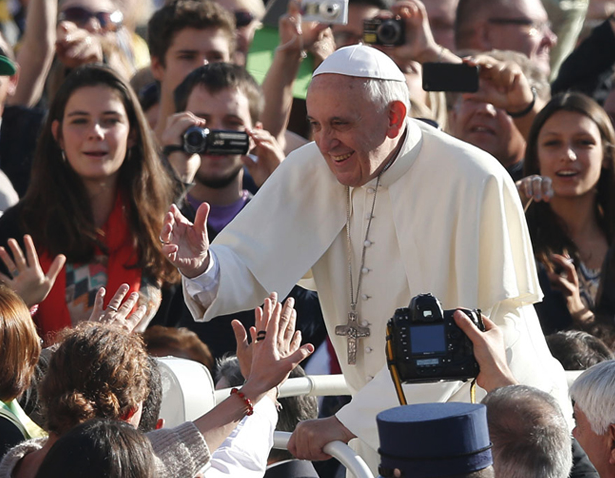Understanding the Exhortation
What Exactly is "Christus Vivit"?
Christus Vivit is an apostolic exhortation (that is, a magisterial teaching document) written by Pope Francis (and released March 25, 2019) as a reflection on the XV (Fifteenth) Ordinary General Assembly of the Synod of Bishops, which took place in October 2018 on the theme of "young people, the faith, and vocational discernment." This exhortation frequently references that Synod and its Final Document, but also provides the Holy Father's own insights that flowed from the process that led up to, included, and followed the October Synod gathering.
In short, Christus Vivit is a significant papal document that gives the Catholic Church's current and central understanding of its approach to youth and young adults.
What Does "Christus Vivit" Mean?
The Latin title of the document, Christus Vivit, is translated in English as "Christ is alive!" - and this understanding is the core of the document. Pope Francis notes that this truth is the foundation to everything that will follow in the exhortation, as Jesus' living presence for and within the lives of young people (and that Christ calls on the entire Church to be young again) is central to the protagonism of a synodal community in relationship with young people and how that community engages the world. (see Christus Vivit 1-2, 34-42).
Language Distinctions: Who are "Young People"?
It is important to remember that, cross-culturally, there are many different ways of referring to "young people." From the perspective of the United States, the word “youth” (as seen within the pages of Christus Vivit) often means something different in this country than what the Vatican documents originally intended to convey.
Question: What do the words “youth,” "young person," or "young people" mean in Christus Vivit?
Answer: Women and men age 16 to 30s (called “youth and young adults” in the United States)
It does NOT only mean adolescents (which is what “youth” typically means in the United States), but it is a more inclusive term that extends through young adulthood and beyond (when adults regain their own "youthfulness" cf. CV 160). When Pope Francis and the Synod Fathers (and other Vatican officials and documents) use the word “youth” in international settings, they mean those age 16 to those in their 30s. This is how “youth” is used in other parts of the world. Please keep this language distinction in mind when reading Christus Vivit.
The Exhortation's Structure: See, Judge, Act
Reflecting the “see, judge, act” pastoral action framework (a classic style used frequently in Latin America), the synodal process and the organization of Pope Francis’ Christus Vivit follows this same structure. During the Synod, the three-fold framework was also given the words, “observe, interpret, choose.”
Chapters 1-3: See | Observe
Pope Francis helps us to see young people in the context of Scripture (Chapter 1), the Church (Chapter 2), and the world today (Chapter 3). This is inclusive of some key observations about youth and young adults he received through the synodal process, especially in his encounters with young people at World Youth Days in Rio (2013), Krakow (2016), and Panama (2019), with the international delegates at the Pre-Synod Meeting (March 2018), and with the young adult auditors at the Synod of Bishops (October 2018).
Chapters 4-6: Judge | Interpret
Pope Francis offers his response to the situation of young people (shared throughout Chapter 3) by providing three essential understandings of life and faith: that God loves us, that Jesus saves us through his death, and that Christ is alive through his resurrection, and gives us hope with the help of the Holy Spirit (Chapter 4). He then shares his commentary on, or assessment of, what it means to be a young person, and how youth and young adults move from dreams to fully participating in today’s global society (Chapter 5). This includes his expression of the great hope he has for young people and intergenerational cohesion (Chapter 6).
Chapters 7-9: Act | Choose
Pope Francis concludes Christus Vivit by pointing to needed improvements and actions in both youth and young adult ministries and by the global Church in response to young people. He outlines ideas for parishes and academic institutions and proposes a radical ministry model beyond church walls and with youth and young adults as the chief protagonists (Chapter 7). He then provides a framework for understanding and acting on one’s calling/vocation in life (Chapter 8) through an intentional process of listening, dialogue, and discernment (Chapter 9).
The entire document is grounded in hope:
Christ is alive, which means that darkness and death do not have the final answer. The situation young people face today, and that the Church faces today, may seem daunting and overwhelming; but a hopeful outlook, aided by the Holy Spirit, who guides our actions, reminds us that if local communities proactively implement Christus Vivit to the fullest, new life will surely emerge.
CNS Stories and Other Coverage
CNS covered all pre- and post-Synod developments in 2017 and 2018. Find full coverage in the Catholic News Service Special Section.
Read Mobilizing the Field Hospital: Pastoral Care as a Paradigm for Ministry with Young Adults, an academic article from Religions journal, on the connection of Christus Vivit and its notion of the "field hospital" with the Church's approach to young adults (18-39) in the United States, by Paul Jarzembowski from the USCCB Secretariat of Laity, Marriage, Family Life and Youth
Read Christus Vivit and Young Hearts that are Witnesses of Justice and Peace, a reflection from Mike Buckler on To Go Forth, a blog from the USCCB Department of Justice, Peace, and Human Development.
Read the Complete Guide to the 2018 Synod from Ave Explores and edited by Katie Prejean McGrady, USCCB representative to the Pre-Synod meeting of young adults in March 2018, and containing articles from various contributors to the overall process.


